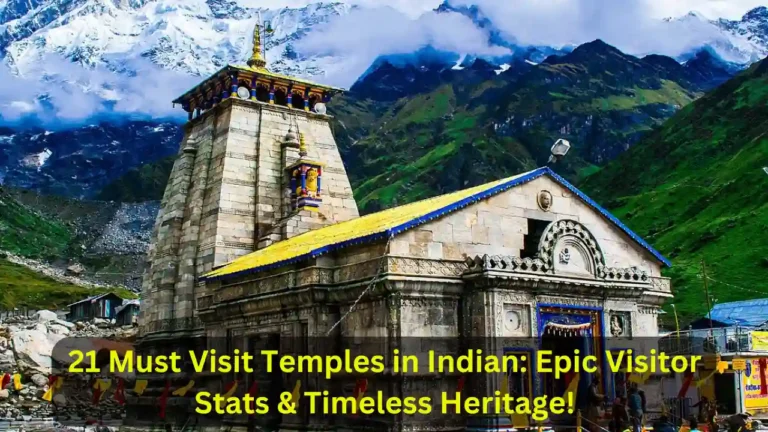How to Visit Kashi Vishwanath Temple: A Detailed Darshan & Travel Guide
The Spiritual Heart of India
The Kashi Vishwanath Temple, often referred to as the Golden Temple of Varanasi, is among India’s most esteemed spiritual destinations. Dedicated to Lord Shiva and believed to be one of the 12 Jyotirlingas, it attracts immense devotion from Hindus worldwide.
According to estimates by the Uttar Pradesh Tourism Department and local temple authorities, the shrine receives over 7 million visitors annually, including approximately 200,000 foreign tourists each year.
Many come for the spiritual aura, while others are drawn by the city’s cultural heritage, represented most vividly in Varanasi’s ancient ghats and timeless rituals along the holy Ganges.
This comprehensive guide will walk you through every aspect of planning your visit—from travel methods to darshan timings, current costs, and real user experiences. Prepare to immerse yourself in a place that seamlessly blends faith, history, and vibrant local life.

Why Kashi Vishwanath Temple Is a Must-Visit
Kashi Vishwanath Temple stands on the western bank of the Ganges, surrounded by a maze of narrow lanes that echo with chanting priests, classical music, and the aroma of local street food. This unique atmosphere, along with the temple’s deep historic roots, makes it a key pilgrimage site and a cultural treasure.
Spiritual & Historical Significance
The temple’s antiquity stretches back centuries, referenced in Puranic texts. Its status as a Jyotirlinga places it among the holiest temples dedicated to Lord Shiva.
Over time, various rulers have contributed to its construction and renovation, most recently culminating in the Kashi Vishwanath Corridor project, which expanded pathways and eased crowd flow.
According to Uttar Pradesh Tourism Board data, the temple’s footfall spikes significantly during Mahashivratri and the holy month of Shravan, with devotees sometimes waiting hours in line. These large congregations speak to its towering spiritual presence across India.
Planning Your Trip: When to Go and What to Pack
- Best Time to Visit: Research suggests the ideal time is from October to March, with pleasant weather and fewer crowds compared to peak summer (April to June) and monsoon (July to September). Festivals like Shivaratri see higher visitor numbers, as mentioned in 5 Things to Know Before Visiting the Kashi Vishwanath Temple – Skyscanner India.
- Dress Code and What to Pack: It seems likely that modest clothing, covering shoulders and legs, is essential due to the temple’s sanctity. Pack comfortable walking shoes, sunscreen, a water bottle, and a small bag for personal items, as the area involves walking through narrow lanes and standing for aartis.
Transportation Options for Kashi Temple
- By Train: Varanasi has two main railway stations, Varanasi Junction and Kashi Junction, with frequent trains from major cities like Delhi (12-14 hours, ₹500-2000) and Mumbai. The evidence leans toward taking a train to Varanasi Junction, then a taxi or auto-rickshaw (3 km, ₹100-200) to the temple.
- By Flight: Lal Bahadur Shastri Airport, 25 km from the temple, has direct flights from Delhi, Mumbai, and Kolkata, taking 1.5-2 hours, with costs from ₹3000-5000. From the airport, taxis (₹500-800) or prepaid cabs are available.
- Local Transport from Station to Temple: From the railway station, auto-rickshaws and taxis are common, with fares around ₹100-200 for the 3 km distance. For the airport, it’s about ₹500-800 for 25 km, ensuring easy access.
How to Reach Kashi Vishwanath Temple by Train
Varanasi boasts robust rail connectivity to major Indian cities, making train travel a favored choice for many domestic visitors.
The city’s principal station, Varanasi Junction (Cantt), is roughly 5 km from the temple. Alternate stations like Manduadih and Mughalsarai (DDU) can also serve as arrival points.

Arriving at Varanasi Railway Station
Once you arrive, you’ll find taxis, auto-rickshaws, and cycle-rickshaws waiting at designated stands.
Fares can vary based on time of day and negotiation, but expect to pay anywhere from INR 80 to INR 150 for an auto-rickshaw ride to the temple. Travel time ranges between 15 and 30 minutes, depending on traffic conditions.
Because the streets around the temple are notoriously narrow, most vehicles stop at a certain point, and you’ll need to walk for another 5–10 minutes.
Many seasoned travelers mention this short walk as an unforgettable experience—a chance to observe the city’s bustling markets, vendors selling fresh flowers for puja, and local residents going about their daily routine.
How to Reach Kashi Vishwanath Temple by Flight
Flying to Varanasi is often the quickest way to arrive if you’re traveling from distant parts of India or internationally. The Lal Bahadur Shastri International Airport is located about 25 km from the temple.
Airport Arrival & Transportation
Domestic flights operate daily from cities like Delhi, Mumbai, Kolkata, and Hyderabad, with some international connections (e.g., Bangkok). A one-way domestic ticket typically ranges from INR 3,000 to INR 8,000, though prices can spike around festive periods such as Diwali or Mahashivratri.
Pre-paid taxi booths inside the terminal offer a straightforward way to hire a cab. You can expect to spend INR 600–800 for a ride to the city center or directly near the temple.
Some budget-conscious visitors prefer shared cabs or auto-rickshaws, although these can be less comfortable for a 45–60 minute drive.
Exploring the Temple: What to See and Do
- Main Sanctum: The main sanctum houses the Shiva Linga, one of the twelve Jyotirlingas, believed to purify the soul. Visiting hours are from 4:00 AM to 11:00 PM, with specific aarti timings.
- Surrounding Areas: Explore the Kashi Vishwanath Corridor, a recent development connecting the temple to the ghats, rediscovering over 40 ancient temples during construction, as mentioned in an X post by @bharatkemandir. Visit nearby ghats like Dashashwamedh for the Ganga Aarti.
- Rituals and Aartis: Key aartis include Mangla Aarti at 4:00 AM, Bhog Aarti from 11:15 AM to 12:20 PM, and Sapt Rishi Aarti at 7:00 PM. An X post by @Sumita327 shares a video of Holi Arti, highlighting the divine atmosphere.
Practical Tips for a Smooth Visit
- Dress Code: Modest clothing is mandatory, covering shoulders and legs, as per temple guidelines on Shri Kashi Vishwanath Official Web Portal.
- Photography Rules: Photography is generally allowed outside but restricted inside the sanctum; check with authorities for updates.
- Security Measures: Keep valuables secure in crowded areas, and follow temple rules for a safe visit.
- Accommodation Options: Stay near Assi Ghat or Dashashwamedh Ghat for convenience, with options ranging from budget guesthouses to luxury hotels.
Transportation Options to Kashi Vishwanath Temple
| Mode of Transport | Time from Delhi | Cost (Approx.) | Convenience |
|---|---|---|---|
| Train | 12-14 hours | ₹500-2000 | Medium |
| Flight | 1.5-2 hours | ₹3000-5000 | High |
Aarti Timings at Kashi Vishwanath Temple
| Aarti Name | Timing |
|---|---|
| Mangla Aarti | 4:00 AM |
| Bhog Aarti | 11:15 AM – 12:20 PM |
| Sapt Rishi Aarti | 7:00 PM |
| Shringar Bhog Aarti | 8:30 PM |
Important FAQ
Based on data from the Uttar Pradesh Tourism Department and temple authorities, over 7 million visitors arrive each year, including around 200,000 foreign tourists.
Special darshan passes range from INR 300–500, offering shorter queues. Prices may vary on major festivals such as Mahashivratri. For the latest updates, check the official temple website.
Phones, cameras, and large bags are not allowed inside. Locker facilities, typically costing INR 20–40 per item, are available near the entrance.
Varanasi Junction (Cantt), located about 5 km from the temple, is the nearest major railway station. Auto-rickshaws or taxis can take 15–30 minutes to reach the temple.
Early morning (around 4–5 a.m.) is generally considered the best for a calmer atmosphere. However, weekdays and non-festival seasons can also be relatively less crowded.
Conclusion
Visiting the Kashi Vishwanath Temple is an inspiring blend of religious devotion, age-old history, and the living tapestry that is Varanasi’s culture.
With 7 million annual devotees, including 200,000 foreigners, the site’s global appeal is unmistakable.
Whether you choose a time-saving flight or an immersive train journey, planning ahead can smooth out the wrinkles—especially when it comes to avoiding festival crowds, securing reasonable transport fares, and preparing for security checks.
Aim for early morning visits to witness the serene Mangala Aarti, and consider exploring the mesmerizing Ganga Aarti at Dashashwamedh Ghat in the evening to complete your spiritual and cultural experience in the City of Light.






